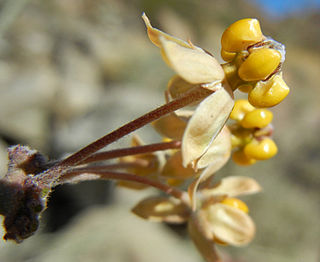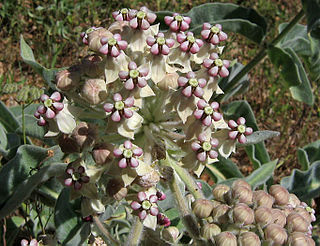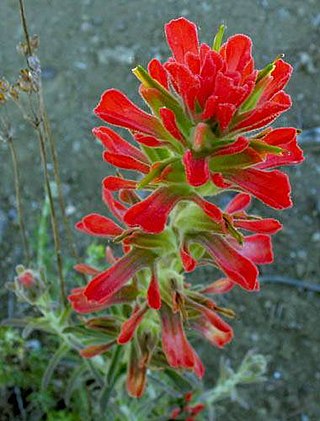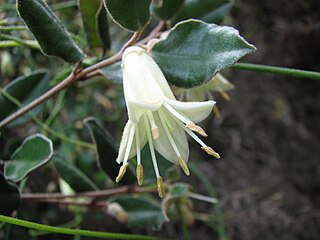
Asclepias californica is a species of milkweed known by the common name California milkweed. It grows throughout lower northern, central and southern California.

Gnaphalium palustre, known by the common name western marsh cudweed, is a species of flowering plant in the family Asteraceae.

Asclepias albicans is a species of milkweed known by the common names whitestem milkweed and wax milkweed. It is native to the Mojave and Sonoran Deserts of California, Arizona, and Baja California. This is a spindly erect shrub usually growing 1 to 3 meters tall, but known to approach 4 meters. The sticklike branches are mostly naked, the younger ones coated in a waxy residue and a thin layer of woolly hairs. The leaves are ephemeral, growing in whorls of three on the lower branches and falling off after a short time. They are linear in shape and up to 3 centimeters long. The inflorescence is an umbel about 5 cm (2 in) wide which appears at the tips of the long branches and sprouting from the sides at nodes. The inflorescence contains many purple-tinted greenish flowers, each about 1.5 cm wide, with a central array of bulbous hoods, and corollas reflexed back against the stalk. In its native range it is an evergreen perennial. The plant usually blooms all year long. The fruit is a large, long, thick follicle which dangles from the branch nodes.

Asclepias eriocarpa is a species of milkweed known by the common names woollypod milkweed, Indian milkweed, and kotolo. It is a perennial herb that grows in many types of habitats.
Astragalus miguelensis is a rare species of milkvetch known by the common name San Miguel milkvetch. It is endemic to five of the eight Channel Islands of California.

Castilleja foliolosa is a species of Indian paintbrush, known by the common names woolly Indian paintbrush and Texas Indian paintbrush.
Chaenactis alpigena is a species of flowering plant in the daisy family known by the common name southern Sierra pincushion. It is native to the High Sierra Nevada and the White Mountains of California, extending in the latter just into Nevada.

Correa backhouseana is a species of rounded shrub that is endemic to coastal and near-coastal areas of southern Australia. It has elliptical to egg-shaped or round leaves that are densely hairy on the lower surface, and cylindrical to funnel-shaped, cream-coloured to pale green or red and yellow flowers.

Olearia phlogopappa commonly known as the dusty daisy-bush or alpine daisy-bush is a species of flowering plant in the family Asteraceae that is commonly found in eastern New South Wales, Victoria and Tasmania. It is a small shrub with greyish-green foliage, daisy-like flowers in white, pink or mauve that can be seen from spring to late summer.

Correa lawrenceana var. grampiana, commonly known as Grampians mountain-correa, is a variety of Correa lawrenceana that is endemic to Victoria, Australia. It is a shrub with elliptical leaves and cylindrical, velvety flowers covered with matted, woolly cream-coloured to yellowish brown hairs.

Asclepias welshii is a rare species of milkweed known by the common name Welsh's milkweed. It is native to southern Utah and northern Arizona, where there are four known occurrences remaining. Most of the plants occur in Coral Pink Sand Dunes State Park, where the habitat has been degraded in many areas by off-road vehicle use. It is a federally listed threatened species of the United States.

Eremophila strongylophylla is a flowering plant in the figwort family, Scrophulariaceae and is endemic to Western Australia. It is a small shrub with distinctive round leaves, yellowish new growth and purple flowers which are white inside. It is similar to Eremophila mackinlayi and Eremophila hygrophana but distinguished from them by characteristics including leaf shape, and the type of hairs on its leaves and branches.

Dasymalla terminalis, commonly known as native foxglove, is a flowering plant in the mint family Lamiaceae and is endemic to the south-west of Western Australia. It is a shrub with its branches, leaves and some of its flower parts densely covered with white, woolly hairs. The leaves are thick and soft and the flowers are tube-shaped, pale to deep pinkish-purple or claret red.

Muniria quadrangulata is a flowering plant in the mint family Lamiaceae and is endemic to Arnhem Land in the Northern Territory. It is a shrub with its branches and leaves covered with a thick layer of woolly hairs and pale yellow flowers in groups of up to nine, surrounded by woolly hairs.

Quoya verbascina, commonly known as golden bush, is a flowering plant in the mint family Lamiaceae and is endemic to Western Australia. It is an erect shrub with its branches and leaves densely covered with woolly hairs. The leaves are often oblong but very variable in shape and the flowers are pinkish-white with pink spots inside and are surrounded by yellow woolly sepals.
Leucospermum profugum, the Piketberg pincushion, is a species of evergreen shrub in the family Proteaceae. It is an endangered species, only known from three close locations in the Western Cape province of South Africa. It has hairless and leathery inverted lance-shaped to oblong leaves tipped with mostly three or four teeth and flattened egg-shaped flowerheads of 9–12 cm (3.5–4.7 in) in diameter, that consist of initially yellowish-orange flowers that later change to salmon pink. From the center of the flowers emerge almost straight styles that jointly give the impression of a pincushion. Flower heads can be found between late September and December.

Leucospermum secundifolium is a low, evergreen shrub that grows along the ground, the tip of the branches slightly rising, which has been assigned to the family Proteaceae. It has narrowly elliptic leaves with a distinct leafstalk, and few-flowered and very small heads of 1–1½ cm (0.4–0.6 in) across. It is called stalked pincushion in English. The sweetly scented flower heads may be found around early December. It is an endemic species that only grows in a small area of the Western Cape province of South-Africa.

Felicia nordenstamii is a flowering shrub in the family Asteraceae. It is found only in South Africa where it grows on limestone hills close to the sea on the southern coast. Felicia nordenstamii is a many-branched shrub growing up to 30 cm (1 ft) tall. The lower parts of the stems are covered in grayish brown bark and the upper stem has many crowded, upwardly angled, alternate leaves with long hairs on the lower surfaces. Large flower heads form at the tips of the branches, each about 41⁄2 cm across, with about thirty purplish blue ray florets surrounding many yellow disc florets.

Mairia coriacea is a perennial plant assigned to the family Asteraceae. It has broad, tough and leathery, evergreen leaves. These have a narrowed foot and an entire margin or a few shallow, irregular teeth. They grow in a rosette directly from the rootstock. The plant produces flower heads with one whorl of white to mauve ray florets around many yellow disc florets, with one or few on top of a dark reddish, woolly stalk. Flower heads appear after the overhead vegetation burnt down, often destroying the leaves in the process. It can be found in the southern mountains of South Africa's Western Cape province. It is called leather leaves in English.

Pomaderris discolor is a species of flowering plant in the family Rhamnaceae and is endemic to south-eastern continental Australia. It is a shrub with woolly-hairy stems, elliptic leaves, and clusters of pale yellowish flowers.

















